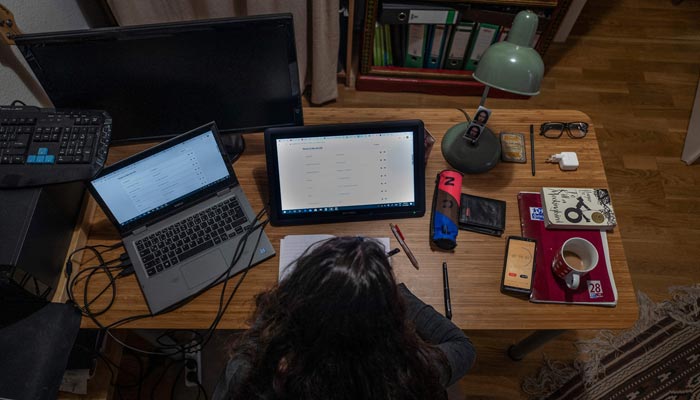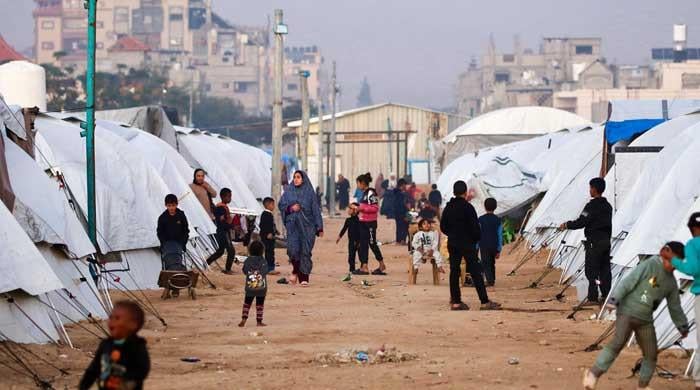The paradox of online learning
Educators received little to no support from their institutions for remote learning during pandemic
March 30, 2022

COVID-management strategies meant different things to people employed in different sectors during the last two years. Non-critical activities came to a stop. This meant either work-from-home (WFH) for those who could (largely white-collar workers) or layoffs and a resultant loss of income (largely blue-collar workers). For those deemed to be in critical jobs, which came to include the food supply chain, logistics, in addition to the healthcare sector, it meant the opposite — more work, no vacations and job security but also a greater risk of exposure and infection.
Among the professionals that did not get a break were educators. Although schools and universities around the world remained closed for extended periods, administrators just ordered educators to "switch to online instruction", dusted off their hands and that was that — their job was done.
However, things were largely chaotic in online classrooms in Pakistan. The situation exposed an utter lack of understanding of university administrators. Educators received little to no support from their institutions — such as training for online instructions or material and equipment support. Videos of what happened in online classes in Pakistan can still be found on YouTube, Facebook and TikTok. Some make you laugh, cringe or mad but they will all make you cry on the inside.
The Chronicle of Higher Education published a series of articles in- and post-pandemic. According to an article by Abi Ross on February 24, many adjunct (contract) faculty in US universities were left to cover the cost of equipment and switching to online instruction from their own pockets.
Nearly 33% covered all costs themselves, only 15% received any hardware, and 56% received technical support. I have yet to meet a faculty member in Pakistan who received any hardware support from their institution.
There are grainy video clips of instructors stuck at home trying to deliver lectures on small whiteboards with barely legible writing in front of smartphone selfie cams/laptop webcams over (generally) lousy internet connections, while struggling with disruptive Zoom-bombing students. For software, most educators were pointed to the free version of Zoom (and told to figure it out) which (at that time) was never intended for widespread classroom use.
To clueless administrators, online classes meant “just do what you do in a classroom in front of a camera.” But as we now know, that is not how WFH panned out for most people. WFH blurred the lines between office hours and private time. The pressure to be "available" while at home meant WFH employees ended up working 24x7. Everything once handled by simply talking to a colleague now required sending/receiving emails, making/fielding calls. The result was increased anxiety, stress and strain.
The way the switch to online education was handled was a scandal. Many critical workers in general, and educators in particular, felt betrayed by their institutions. Universities’ lack of responsiveness invalidated faculty’s resource requests and safety concerns during the pandemic.
As vaccines began to roll out and become widely available over the course of 2021, restrictions gradually eased. However, by this time a large portion of workers, critical workers in particular, had been continuously subject to these WFH stresses, lockdowns and curfews for a year or more. What came next in the wider economy is now known as 'The Great Resignation’ which continues to this day. The pandemic made many workers re-evaluate their lives and priorities. Many low-wage workers deemed critical resigned in droves, particularly in countries that disbursed financial assistance payments to their populations. The result has been a shortage of workers, rising wages contributing to higher prices.
In academia, The Great Resignation manifested itself differently. Most educators may not fit into the low-wage category, but that did not make the burnout they experienced any less real. What followed in academic circles was very well captured by Kevin R. McClure and Alisa Hicklin Fryar in a January 19, 2022 article titled "The Great Faculty Disengagement", which has its own discussion thread on the /r/Professors subreddit. Many close to retirement age decided to bow out early. Faculty continues to do what it must (teach classes, supervise graduate students) but little more. Many have scaled back on volunteering their time for assignments, something academic departments greatly depend on.
While the Great Disengagement is being rendered differently in different countries, it is not confined to any region or country. We are seeing anecdotal effects of this disengagement by faculty in other countries spilling over into Pakistani academia. There appear to be fewer takers for openings, giving applicants from countries like Pakistan a better chance of ‘leveling up’.
In the UK in particular, post-Brexit has levelled the field for applicants from outside the EU for both faculty positions and doctoral student positions. Universities in the Middle East and Saudi Arabia in particular employ a good number of Pakistani faculty members. The pull of a greater number of opportunities internationally, coupled with the push of a partial moratorium on hiring and promotions in public universities in Saudi Arabia, is propelling many Pakistanis onwards.
Generally, Pakistani faculty have established a good reputation as hard-working staff members for themselves in Middle Eastern universities. Many of the openings they are leaving behind will also go to fellow Pakistanis. At one university, the abnormally large number of departing Pakistani faculty members this year prompted a senior administrator to ask: “Why are so many Pakistani brothers leaving?” For Pakistani faculty, "The Great Disengagement" internationally is turning into an opportunity to make their Great Escape.
It has been two years since the pandemic forcefully introduced Pakistani universities to online higher education. Since then it seems universities have identified online education for some programmes as a money-making opportunity but have done little to improve their understanding of what it will take to do it right — the few universities that are making noises about Massive Open Online Courses (MOOCs) a la Coursera, edX, Udemy, etc have not developed a credible strategy.
The HEC’s Online Readiness Model Policy dated April 2020 available on its website lists a lot of indicators for universities to assess if they are ready for online education. In my opinion, it puts a disproportionate emphasis on the peripherals and lumps what I consider the pedagogical hard nut to crack into two check-boxes (items 2.1 and 2.2). Little surprise then that the statistics published for ‘Online Classes Readiness’ claims that out of more than 47,000 university courses, more than 44,000 are ready to go online.
The ‘Online readiness score’ of every province ranges between 80 and 90%. University, course, faculty, technology, library, student and evaluation readiness scores for online learning all range between 80 and 95%. Only the laboratory readiness score is around 64%. Universities received a request for information from the HEC, administrators simply reported back that all is well without bothering to find out the state of affairs in classrooms.
These tall claims give the impression that all is well but are not reflected in feedback received during recent fact-finding sessions with students and faculty but rather suggest that these numbers are fairy tales. Although universities have reopened and online education of pandemic times is now in the rear view mirror, in recent conversations with large groups of students and faculty members, the vast majority are still unanimously shaken up by how badly universities did.
In "The Great Upheaval" (2021), Arthur Levine and Scott J. Van Pelt had this to say about the transformation of faculty at the traditional university becoming online education providers: “Currently composed of subject-matter experts engaged in teaching and research, the ranks [of faculty in traditional universities] will be diversified to include learning designers, instructors, assessors, and technologists.” This is euphemistically called the ‘disaggregated faculty model.’”
What still escapes our local guidelines and policies is that the real transformation that needs to happen to offer online courses or MOOCs means fundamentally transforming the process of course development from an individual to a team effort. This is the hard part of the MOOC puzzle. Acquiring associated infrastructure (for example: data center resources to host courses, a MOOC delivery platform) can be acquired or rented as subscriptions.
The HEC’s encouragement of universities to explore offering online courses is good thinking but needs to be done right. Universities should not be pressured into offering online education, like they were pressured into launching PhD programmes in decades past, without an honest assessment of whether the institution has the capacity and readiness to do so. This approach could be trialled with shorter programmes like certificate and associate bachelor's programmes not requiring lab equipment. But to gain legitimacy, universities need to demonstrate that the learning these online programmes offer is at least equivalent to that of their on-campus counterparts. A key challenge in this regard will be to ensure that assessments for online programmes are just as credible (free of plagiarism, cheating) as assessments conducted in on-campus programmes.
We just went through two years of disruption, but business continues as usual. The floodwaters may have receded, but a lot of lessons still need learning.
The writer has a PhD in Education.
Originally published in The News









